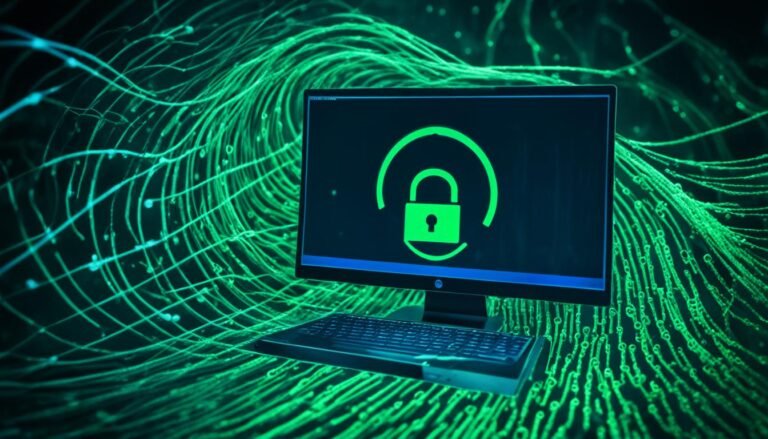AI-Powered Threats: The rise of AI in cybersecurity attacks and defenses.
Artificial intelligence (AI) is changing many fields, including cybersecurity. But, did you know AI threats are growing fast, threatening our online safety? Studies show AI attacks could make up 30% of all cyber threats by 2025. This fact shows how big a role AI plays in cybersecurity.
AI helps improve security, but it also brings new challenges. Cybercriminals use AI for complex attacks. This makes AI a powerful tool for both sides: it helps protect us and it helps hackers.
This article will look into AI threats in cybersecurity. We’ll talk about the dangers and how to defend against them. We’ll cover the types of AI attacks and how AI can help in defense. We’ll also look at real examples of AI in cybersecurity and the challenges it brings. Finally, we’ll peek into the future of AI threats.
Key Takeaways:
- AI-powered attacks are projected to account for 30% of all cyberattacks by 2025.
- AI is a double-edged sword in cybersecurity, enabling both enhanced defense strategies and more sophisticated attacks.
- This article will explore AI-powered cyber attacks, defenses, real-world implementations, and future challenges.
AI-Powered Cyber Attacks
Cybercriminals are always finding new ways to use technology for their bad deeds. Now, they’re using AI-powered systems for more complex attacks. These tools help them attack more efficiently and effectively.
Malicious AI systems are a big threat to online safety. They use machine learning to avoid being caught and get past old security methods. They keep learning and changing, making it hard for antivirus to stop them.
Cybercriminals are also selling AI-enhanced ransomware on the dark web. This lets even beginners use powerful ransomware tools. These tools can encrypt files, take secure payments, and target victims smartly.
AI helps make phishing attacks look more real and targeted. It looks at social media and other public info to make emails that seem like they come from someone you know. This makes these attacks much more likely to work.
AI is also used to control botnets, which can launch big DDoS attacks. These attacks can make websites or services unavailable, causing big problems for businesses and important systems.
AI tools can quickly scan for and use system weaknesses. This means hackers can find and use vulnerabilities fast, making attacks quicker and easier.
AI makes cyber threats worse, so we need to keep improving our defenses. Knowing how malicious AI works helps security experts fight back against these threats.
By staying up to date and proactive, companies can protect against AI attacks. This helps keep their data and systems safe from new cyber threats.
AI-Powered Defenses
AI is changing how we fight cyber threats. It helps both hackers and defenders. AI boosts the power of security tools, helping organizations protect against new threats and respond fast to security issues.
AI-Driven Threat Detection
AI helps Security Information and Event Management (SIEM) systems. They collect and analyze security data from networks. AI spots patterns and oddities, making threat detection better. This lets security teams quickly find and act on threats.
Next-generation firewalls with AI can spot and sort network traffic fast. They catch security breaches, like unauthorized access or malware, in real-time.
Behavioral Anomaly Detection and Protection
AI looks at network and user actions to find odd behavior. It spots signs of a cyber attack. This way, AI helps stop security breaches and tackle threats early.
Endpoint Protection and Incident Response
AI helps Endpoint Detection and Response (EDR) tools watch endpoint activities. They find and stop threats early, reducing the chance of security issues.
Security Orchestration, Automation, and Response (SOAR) use AI to make responding to incidents faster. AI helps automate and improve how teams work together, making responses quicker and more effective.
Data Loss Prevention and Content Analysis
AI in Data Loss Prevention (DLP) tools checks content and watches user actions to stop unauthorized sharing of sensitive info. They automatically spot and protect sensitive data, keeping it safe and in line with rules.
Using AI, organizations can boost their security against threats. AI improves threat detection, automates responses, and stops data leaks. AI is key to protecting important assets and keeping security strong.
Real-world Implementation of AI-Powered Cybersecurity
AI-driven cybersecurity solutions have shown to be very effective against modern cyber threats. A global financial institution faced a wave of complex attacks on their data and customer info. They chose to add AI to their Security Operations Center (SOC) to strengthen their defenses.
Adding AI to their SOC gave the institution new cybersecurity tools. These tools helped improve threat detection, automate responses, and use predictive analytics to predict attacks.
AI-powered cybersecurity made the institution more efficient. It automated tasks like log analysis and threat hunting. This meant human analysts could focus on more important tasks. It helped the institution use resources better and tackle threats early.
Using AI with tools like SIEM, EDR, SOAR, IPS/IDS, firewalls, and DLP created a strong defense. This approach covered all angles, making it hard for attackers to breach.
Benefits of AI-Driven Cybersecurity Solutions:
- Enhanced threat detection capabilities
- Automated incident response
- Predictive analytics for proactive defense
- Improved security efficiency through task automation
- Integration with existing security tools for a multi-layered defense
By using AI in their cybersecurity, organizations can stay ahead of cyber threats. AI is now key to a strong cybersecurity plan, given the constant changes in threats.
Challenges and Considerations
AI is changing cybersecurity by making defenses stronger and spotting threats better. But, it has its challenges and things to think about. Companies need to tackle these issues to use AI in cybersecurity well and ethically.
False Positives and Alert Fatigue
AI can spot potential threats, but it might also make mistakes. This can lead to too many alerts, overwhelming security teams. It’s important to make the algorithms better to cut down on these mistakes.
Also, having humans check and sort through alerts is key. This way, teams can focus on real threats.
Adversarial Attacks
Adversarial attacks are a big worry for AI in cybersecurity. These attacks try to mess with AI models and algorithms to get past security. Keeping AI systems up to date and testing them well is crucial to fight these attacks.
Ethical and Privacy Concerns
Using AI in cybersecurity ethically is very important. AI needs a lot of data, so companies must collect and use it right. They must respect privacy and keep sensitive info safe.
AI can also make biased decisions, which is a big worry. It’s key to be open about how AI works and to use data responsibly. This helps deal with ethical issues.
To overcome these challenges, companies should be open and have strong rules. Following the law and building trust in AI systems is crucial. This makes AI in cybersecurity effective in fighting new threats.
“AI has a lot of potential in cybersecurity, but it also brings challenges. Companies need to find a balance between using AI and dealing with ethical and privacy issues.” – Emily Robinson, Cybersecurity Expert
The Future of AI-Powered Threats in Cybersecurity
Technology is changing fast, and so is cybersecurity. Artificial intelligence (AI) is now a big part of our digital world. It brings new threats but also new ways to fight them.
AI-powered cyber attacks are starting to show up. They use machine learning to find and use weaknesses in systems. These attacks can change quickly, making them hard to catch and stop. They range from phishing to ransomware, making them more dangerous.
But AI isn’t just for the bad guys. It helps defenders too. AI can look through lots of data, find patterns, and act fast to stop threats. This makes fighting cybercrime better, faster, and stronger.
The future of AI in cybersecurity is huge. As AI gets smarter, defenders can make better security tools. Using AI, companies can spot problems, find oddities, and predict dangers more accurately.
When using AI, we must think about ethics and responsibility. Companies should make sure AI tools respect privacy and are clear about what they do. Keeping AI systems updated and checked is key to avoid bias and keep security strong.
With AI changing cybersecurity, companies need to be ready and flexible. They should use AI to defend themselves, manage risks well, and stay alert to new dangers. By using AI wisely and updating their plans, companies can keep up with threats.
As AI threats grow, companies need to invest in skilled cybersecurity workers. They should work together with AI to use it fully in fighting cyber threats.
Conclusion
AI-powered threats are becoming a big problem for companies in cybersecurity. The use of AI in both attacks and defenses has changed how we protect digital security. AI helps defenders find and respond to threats better, but cybercriminals use it to make attacks harder to spot.
It’s important for companies to use AI in their cybersecurity plans to stay safe. AI helps with threat intelligence, automated responses, and better anomaly detection. This way, companies can beat malicious actors and reduce risks.
But, using AI in defense comes with its own problems. False positives can cause unnecessary alarms and use up resources. Adversarial attacks can also make defenses less effective.
There are also ethical issues with AI in cybersecurity. As AI gets better, we need rules to make sure it’s used right. Finding the right balance between AI’s benefits and privacy, transparency, and accountability is key in the fight against cyber threats.







